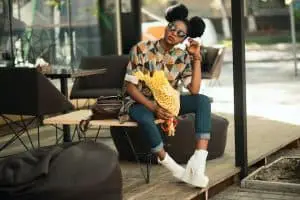Introduction
As we’ve seen in other posts, such as From Material Sourcing to Effective Distribution. Understanding the supply chain in the fashion industry is the primary step to pursuing environmental sustainability goals. As a result, we can break down the supply chain in 4 essential tiers:
- Tier 4. Raw Material Suppliers. These suppliers are in direct connection with nature and as such, the timing of their operations of production have to be closely connected to the rest of the supply chain.
- Tier 3 and 2: Raw Material Processing and Subcomponent Supplier. In this case, we see that production suppliers are both processing fibers while at the same time working with subcontractors to develop secondary processing, such as embroidery.
- Tier 1. Manufacturing. In this case, again, manufacturing takes into account both the environmental impact of manufacturing processes, as well as the human component represented by human labor.
- Tier 0. The Brand. In this context, as we’ve seen in posts such as Understanding How to Build A Sustainable Brand. A brand is capable of influencing the way products are used, reused and recycled thanks to the momentum it has been able to develop in relationship to environmental goals.
By looking at the complexity of the fashion pipeline, we are quick to realize that those larger conglomerate companies who pursue a vertical integration strategy (by owning or controlling directly all the segments of their value chain) are in a position of advantage. This is because, in order to lower an environmental impact, business decisions need to be made both in terms of strategic vision, managerial attitude and operational tasks. As we look at the new initiatives that can be undertaken when it comes to environmental sustainability, we see how commercial viability is to be only considered table stakes. As the ultimate goal of a company is to establish trust with its consumers.
In this context, a fashion firm needs to be capable of delivering an image of transparency and direct accountability in order to communicate believable brand values. So in this post, we are going to discuss three models that can be used to innovate fashion.
- Developing More Sustainable Products
- Developing New Business Models
- Using New Technological Breakthroughs: Blockchain Technology
- Conclusions
1. Developing More Sustainable Products
Firms which are producing too much are damaging the environment, even if each product has a small environmental impact.
This should make us think about ways in which products can be designed to serve more people, or at least serve one person for a longer amount of time. Once a customer has purchased our products, there is no way a firm can control the use and disposal of the purchase, and that’s when branding plays a role.
However, in order to foster a stronger connection between our products and their lifecycle, much can be done, in terms of the business model pursued by the company. This is going to be discussed in the next section, where we are not trying to push innovative products, as much as innovative business models.
2. Developing New Business Models
In order to foster a customer experience capable of giving value to fashion sustainability, new business models can be achieved by taking advantage of share economies. Share economies are grounded on the idea that ownership is not as important as experience.
Customers realize that investing in ownership limits their monetary power, as opposed to renting. Rental is the new ownership, and as we’ve seen in the post: Fashion Sustainability Through Design Innovation there are now many companies who are essentially becoming the world’s largest dry-cleaners, as they are allowing for customers to only pay for the use of those clothing items, that can only be worn in specific and unrepeatable circumstances. The value of making fashion and luxury items available to a wider range of customers is in itself a disruptive innovation, capable of expanding the market and making businesses able to access a much wider customer pool. Disruptive innovation is only one of the 4 main typologies of innovation, which are addressed in more detail in this post.
As a result, we can see that access to more innovative business models is connected to technological leaps, and this is why it’s in the new technological innovations that fashion sustainability can find new exciting business landscapes. An example of this is provided by blockchain technologies which are addressed in the following segment of our post.
3.Using Technological Breakthroughs: Blockchain Technology
As we’ve seen in other segments of our blog, the main challenge for fashion firms pertains to showing accountability and transparency in their supply chain. However, this is difficult to do, because, in reality it’s hard to persuade customers that a garment is actually part of a sustainable lifecycle. Customers don’t believe brands at face value, even when fair trade and fair sourcing certifications are being provided.
Blockchain technologies offer an interesting opportunity for companies who want to create a new and undeniable system of supply chain management and product tracing.
As we may know, blockchain technologies, were not actually developed for this purpose. Blockchain is a technology which was created to provide a decentralized system of online transaction based on a ledger which relies on community validation. The result of this alternate transactional economy is the bitcoin, as well as many other cryptocurrencies.
But how does this apply to fashion? Quite simply, the same system of ledger validation and community validation can be used to show the traceability of fashion products. According to this approach, firms can provide unique traceability to each product they sell, so that a customer may be able to reconstruct each stage of its development, from the farm where the cotton was cultivated to the company that processed the fibers, to the plant that manufactured the item, before the brand or tag was even added.
This technology, as it sets a new, inescapable standard to trace production and provide accountability to the final customers, will end up revolutionizing the industry and creating the premises for new business transparency.
4.Conclusions
As we’ve seen in this post, the new business challenges in fashion can be addressed with a variety of tools, which span from product innovation to business model innovation to technological and software innovation. This allows us to understand that fashion sustainability, is not to be perceived as a limitation for businesses, who need to fulfill more and more costly and stringent requirements to maintain market viability. On the contrary, it’s because of the opportunities offered by the changing demands of the market, that fashion firms can find unique value propositions capable of tapping into new blue oceans of opportunity.







